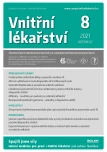Optimal potassium levels in patients with heart failure
Authors:
Radek Pudil
Authors‘ workplace:
1. interní kardioangiologická klinika LF UK a FN Hradec Králové
Published in:
Vnitř Lék 2021; 67(8): 459-464
Category:
Review Articles
Overview
Heart failure therapy involves the use of a number drugs that significantly affect potassium levels. While diuretics decrease potassium levels, others (angiotensin converting enzyme inhibitors, AT2 receptor blockers, sacubitril/valsartan, spironolactone) increase. Patients also have several comorbidities that can significantly reduce renal function and thus affect the resulting potassium level. Decreased or elevated potassium levels can be very dangerous for the patient and therefore need to be monitored. In recent years, the results of several studies have been published that have focused on potassium levels and mortality and have shown that the optimal potassium levels in patients with heart failure should be between 4–5 mmol/L.
Keywords:
heart failure – mortality – optimal level of kalemia – potassium
Sources
LITERATURA 1. McDonagh TA, Metra M, Adamo M, Gardner RS, Baumbach A, Bohm M, Burri H, Butler J, Celutkiene J, Chioncel O, Cleland JGF, Coats AJS, Crespo‑Leiro MG, Farmakis D, Gilard M, Heymans S, Hoes AW, Jaarsma T, Jankowska EA, Lainscak M, Lam CSP, Lyon AR, McMurray JJV, Mebazaa A, Mindham R, Muneretto C, Francesco Piepoli M, Price S, Rosano GMC, Ruschitzka F, Kathrine Skibelund A, Group ESCSD. 2021 ESC Guidelines for the diagnosis and treatment of acute and chronic heart failure. Eur Heart J. 2021;42(36):3599–3726.
2. Siegfierd R. The Discovery of Potassium and Sodium, and the Problem of the Chemical Elements. Isis. 1963;54:247–258.
3. Miller HG. Potassium in animal nutrition, potassium in its relation to the growth of young rats. Jour Biol Chem. 1923;55:61–78.
4. Follis RH O‑KE, McCollum EV. The Production of Cardiac and Renal Lesions in Rats by a Diet Extremely Deficient in Potassium. Am J Pathol. 1942;18(1):29–39.
5. Skou JC. The influence of some cations on an adenosine triphosphatase from peripheral nerves. Biochim Biophys Acta. 1957;23(2):394–401.
6. Rysava R. Hypokalémie. Interní Med. 2006;9:385–388.
7. Skogestad J, Aronsen JM. Hypokalemia‑Induced Arrhythmias and Heart Failure: New Insights and Implications for Therapy. Front Physiol. 2018;9:1500.
8. Bowling CB, Pitt B, Ahmed MI, Aban IB, Sanders PW, Mujib M, Campbell RC, Love TE, Aronow WS, Allman RM, Bakris GL, Ahmed A. Hypokalemia and outcomes in patients with chronic heart failure and chronic kidney disease: findings from propensity‑matched studies. Circ Heart Fail. 2010;3(2):253–260.
9. Aldahl M, Jensen AC, Davidsen L, Eriksen MA, Moller Hansen S, Nielsen BJ, Krogager ML, Kober L, Torp‑Pedersen C, Sogaard P. Associations of serum potassium levels with mortality in chronic heart failure patients. Eur Heart J. 2017;38(38):2890–2896.
10. Leier CV, Dei Cas L, Metra M. Clinical relevance and management of the major electrolyte abnormalities in congestive heart failure: hyponatremia, hypokalemia, and hypomagnesemia. Am Heart J. 1994;128(3):564–574.
11. Osadchii OE. Mechanisms of hypokalemia‑induced ventricular arrhythmogenicity. Fundam Clin Pharmacol. 2010;24(5):547–559.
12. Packer M. Potential role of potassium as a determinant of morbidity and mortality in patients with systemic hypertension and congestive heart failure. Am J Cardiol. 1990;65(10):45E–51E; discussion 52E.
13. Sidhu K, Sanjanwala R, Zieroth S. Hyperkalemia in heart failure. Curr Opin Cardiol. 2020;35(2):150–155.
14. Weir MR, Rolfe M. Potassium homeostasis and renin‑angiotensin‑aldosterone system inhibitors. Clin J Am Soc Nephrol. 2010;5(3):531–548.
15. Linde C, Qin L, Bakhai A, Furuland H, Evans M, Ayoubkhani D, Palaka E, Bennett H, McEwan P. Serum potassium and clinical outcomes in heart failure patients: results of risk calculations in 21 334 patients in the UK. ESC Heart Fail. 2019;6(2):280–290.
16. Collins AJ, Pitt B, Reaven N, Funk S, McGaughey K, Wilson D, Bushinsky DA. Association of Serum Potassium with All‑Cause Mortality in Patients with and without Heart Failure, Chronic Kidney Disease, and/or Diabetes. Am J Nephrol. 2017;46(3):213–221.
17. Nunez J, Bayes‑Genis A, Zannad F, Rossignol P, Nunez E, Bodi V, Minana G, Santas E, Chorro FJ, Mollar A, Carratala A, Navarro J, Gorriz JL, Lupon J, Husser O, Metra M, Sanchis J. Long‑Term Potassium Monitoring and Dynamics in Heart Failure and Risk of Mortality. Circulation. 2018;137(13):1320–1330.
18. Hoss S, Elizur Y, Luria D, Keren A, Lotan C, Gotsman I. Serum Potassium Levels and Outcome in Patients With Chronic Heart Failure. Am J Cardiol. 2016;118(12):1868-1874.
19. Matsushita K, Sang Y, Yang C, Ballew SH, Grams ME, Coresh J, Molnar MZ. Dyskalemia, its patterns, and prognosis among patients with incident heart failure: A nationwide study of US veterans. PLoS One. 2019; 14(8): e0219899.
20. Desai AS, Liu J, Pfeffer MA, Claggett B, Fleg J, Lewis EF, McKinlay S, O‘Meara E, Shah SJ, Sweitzer NK, Solomon S, Pitt B. Incident Hyperkalemia, Hypokalemia, and Clinical Outcomes During Spironolactone Treatment of Heart Failure With Preserved Ejection Fraction: Analysis of the TOPCAT Trial. J Card Fail. 2018;24(5):313–320.
21. Cooper LB, Hammill BG, Peterson ED, Pitt B, Maciejewski ML, Curtis LH, Hernandez AF. Consistency of Laboratory Monitoring During Initiation of Mineralocorticoid Receptor Antagonist Therapy in Patients With Heart Failure. JAMA. 2015;314(18):1973–1975.
22. Ferreira JP, Butler J, Rossignol P, Pitt B, Anker SD, Kosiborod M, Lund LH, Bakris GL, Weir MR, Zannad F. Abnormalities of Potassium in Heart Failure: JACC State‑of‑the‑Art Review. J Am Coll Cardiol. 2020;75(22):2836–2850.
Labels
Diabetology Endocrinology Internal medicineArticle was published in
Internal Medicine

2021 Issue 8
Most read in this issue
- SGLT2 inhibitors – a new pillar for the treatment of heart failure
- Renal parenchymal hypertension: relevant new aspects
- Optimal potassium levels in patients with heart failure
- Antibiotic treatment issues in patients with COVID-19
